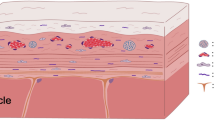Abstract
Cross-sectional images from sciatic nerve that include surrounding structures such as fat and muscles have the advantage of revealing features that are lost once these structures are removed from the anatomical section during the dissection process. This type of extensive anatomical tissue section enables identification of the entire nerve structure as well as its neighboring structures, including collagen layers delimiting compartments around the nerve that are filled with fat. Each compartment is enclosed by a layer formed of collagen fibers, identical in nature to the epineurium located outside the nerve. The fat present in these compartments is similar to that found among groups of fascicles.
Access provided by Autonomous University of Puebla. Download chapter PDF
Similar content being viewed by others
Keywords
- Sciatic nerve
- Tibial nerve
- Common peroneal nerve
- Paraneurium
- Paraneural sheath
- Paraneural compartment
- Epineurium
- Common epineural sheath
Cross-sectional images from sciatic nerve that include surrounding structures such as fat and muscles have the advantage of revealing features that are lost once these structures are removed from the anatomical section during the dissection process. This type of extensive anatomical tissue section enables identification of the entire nerve structure as well as its neighboring structures, including collagen layers delimiting compartments around the nerve that are filled with fat. Each compartment is enclosed by a layer formed of collagen fibers, identical in nature to the epineurium located outside the nerve. The fat present in these compartments is similar to that found among groups of fascicles. The images in this chapter show sequential anatomical sections of this type, from proximal to distal locations. Collagen layers giving origin to compartments around the nerve may be generally known as perineurial sheaths, and compartments filled with fat as paraneural compartments [1, 2]. The concentric distribution of paraneural compartments along the nerve varies according to the topographic region being examined. These compartments contain fat, small vessels, and capillaries.
Images from anatomical sections show paraneural sheaths extending towards larger, neighboring blood vessels and groups of muscles. The structure of sheaths of this type is similar to that of fascias enclosing groups of muscle cells. Capillaries are often found along the trajectory of paraneural sheaths. Paraneural sheaths may contribute to the protection of nerves against compression and stretching during articular movement. Paraneural compartments facilitate longitudinal displacement of nerves controlling body movement.
The inspection of images obtained from successive cuts performed at sequential intervals of 1 cm on a single nerve show that these concentric compartments vary in shape, number, thickness, and distribution. Images in this chapter show serial cuts from the sciatic nerve and its neighboring structures, extending from the subgluteal region to the popliteal region. For identification purposes, the femoral region here comprises the extent limited cranially by the subgluteal region and caudally by the popliteal region.
In addition to the term paraneural sheath, other names that may refer to the same anatomical structure include paraneurium, common epineural sheath, conjunctiva nervorum, adventitia, or neural fascia (Figs. 11.1, 11.2, 11.3, 11.4, 11.5, 11.6, 11.7, 11.8, 11.9, 11.10, 11.11, 11.12, 11.13, 11.14, 11.15, 11.16, 11.17, 11.18, 11.19, 11.20, 11.21, 11.22, 11.23, 11.24, 11.25, 11.26, 11.27, 11.28, 11.29, 11.30 and 11.31).
References
Reina MA, Arriazu R, Collier CB, Sala-Blanch X, Izquierdo L, de Andrés J. Electron microscopy of human peripheral nerves of clinical relevance to the practice of nerve blocks. A structural and ultrastructural review based on original experimental and laboratory data. Rev Esp Anestesiol Reanim. 2013;60:552–62.
Sala-Blanch X, Reina MA, Ribalta T, Prats-Galino A. Sciatic nerve structure and nomenclature: epineurium to paraneurium: Is this a new paradigm? Reg Anesth Pain Med. 2013;38:463–5.
Author information
Authors and Affiliations
Corresponding author
Editor information
Editors and Affiliations
Rights and permissions
Copyright information
© 2015 Springer International Publishing Switzerland
About this chapter
Cite this chapter
Reina, M.A., Sala-Blanch, X. (2015). Cross-sectional Microscopic Anatomy of the Sciatic Nerve and Paraneural Sheaths. In: Reina, M., De Andrés, J., Hadzic, A., Prats-Galino, A., Sala-Blanch, X., van Zundert, A. (eds) Atlas of Functional Anatomy for Regional Anesthesia and Pain Medicine. Springer, Cham. https://doi.org/10.1007/978-3-319-09522-6_11
Download citation
DOI: https://doi.org/10.1007/978-3-319-09522-6_11
Published:
Publisher Name: Springer, Cham
Print ISBN: 978-3-319-09521-9
Online ISBN: 978-3-319-09522-6
eBook Packages: MedicineMedicine (R0)


































